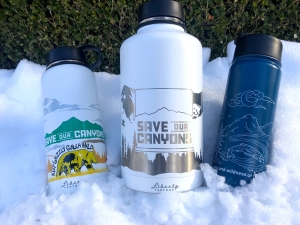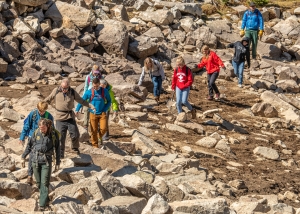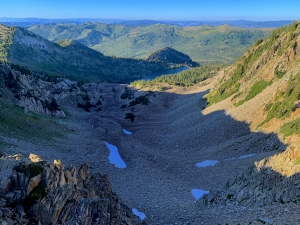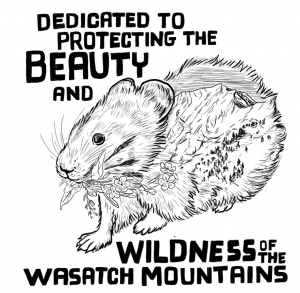Grace Tyler
Comments for Little Cottonwood EIS in 2019
Wasatch Environmental Update for December 15, 2019
By John Worlock
Comments for Little Cottonwood EIS in 2019
Here are some words from those preparing the Environmental Impact Statement for traffic in Little Cottonwood Canyon:
“The purpose of the EIS is not to increase or decrease the number of people in the canyon. Rather, the underlying purpose is to solve a transportation issue that affects local travel and recreation and tourism experiences.
The USDA Forest Service has determined that many areas on the Uinta-Wasatch-Cache National Forest may handle increased use, without significant resource impacts, while maintaining quality recreation experiences for visitors, and is therefore not presently considering limiting access.”
The comment period for the Little Cottonwood Environmental Impact Statement ended last Friday, December 13, but I thought you’d like to know what I told them about future traffic in Little Cottonwood Canyon. Here’s my statement:
“We are fortunate that there is a single public access point to the Little Cottonwood Canyon. We must begin to plan NOW for the near future when we will have to limit human access into the canyon. The Forest Service must begin the process of determining the ‘carrying capacity’ of the canyon's finite resources. Plunging ahead with plans to increase without limit the numbers of humans entering the canyon is insane. Zion and Yosemite National Parks learned this lesson long ago, and Arches is trying to learn it right now. We should begin to think about electronic links between the canyon's mouth and some of the crucial access points, such as trailheads, resort parking lots and avalanche barriers. There IS A LIMIT to the tourism that the canyon can entertain without serious degradation of its special, and precious, characteristics. More buses and fewer cars might be a satisfactory stop-gap solution, but eventually there must be limits to visitation. We are told of predicted Salt Lake Valley population increases of 50%. It should be obvious that Little Cottonwood Canyon cannot support similar increases in visitation.
So we need to begin to plan NOW to find the policies and practices that will be activated to preserve ‘the Wildness and the Beauty’ of Little Cottonwood Canyon.”
Just my own personal thoughts and hopes about the future of Little Cottonwood Canyon.
The National Environmental Policy Act at 50
Wasatch Environmental Update for December 8, 2019
By John Worlock
The National Environmental Policy Act at 50
When we celebrate the New Year this year on January First, we will also be celebrating the 50th anniversary of The National Environmental Policy Act, popularly known as NEPA. It was signed by President Nixon in the heady days of emerging environmental awareness. Nixon is quoted as suggesting that with NEPA, “America pays its debt to the past by reclaiming the purity of its air, its water and our living environment.”
Adam Sowards, an environmental historian, writing in High Country News, tells us of NEPA’s optimistic promises, but then gives us a sobering analysis of NEPA’s significance and its disappointing development over its five decades. It started with the belief that economic growth, environmental protection and human welfare could live in productive harmony.
But the procedural hurdle of the Environmental Impact Statement changed the ways federal agencies made their plans, requiring interdisciplinary studies and inviting public comment, in order to protect what the law calls “productive harmony.”
It didn’t take long for the courts to make the goals of NEPA flexible so that by 1989 agencies were no longer forbidden to undertake unwise activities, but only uninformed ones. Thus Environmental Impact Statements are required, and options laid out, but agencies don’t have to choose the best one.
And so it stands. Agencies must still go through the costly and time-consuming processes of preparing Environmental Impact Statements. They are still valuable, especially to environmentalists, as the discovery and explication of a region’s environmental characteristics is worthwhile just by itself.
But there are current attempts to gut the NEPA even further, for example, exempting the Forest Service from its rules. They can argue that, underfunded and understaffed as they are, they cannot afford the expense and the delay. The counter to that argument is that a nation that values its environment should provide the resources to protect it.
In closing we’ll quote NEPA’s opening section, which asserts that “ each person should enjoy a healthful environment, and each person has a responsibility to contribute to the preservation and enhancement of the environment.”
It’s time for us to get together and add to our environmental responsibilities, that of reviving the National Environmental Policy Act of 1970.
Let's Eliminate Single Use Products In The Wasatch.
Dozens of movies ranging from Wall-E to Blade Runner have depicted a population that has ruined all ecosystems and filled the world with trash – among other things. The levels of garbage that we produce has humans is overwhelming. A World Bank report projects that the amount of solid waste we generate on earth will double by the year 2025. If current trends continue, we are likely to go from 3.5 million tons to 6 million tons per day by that point. If that’s not bad enough, the figures predict that trash production will only keep growing for the foreseeable future.
Plastic, it turns out, is a much worse and more immediate problem for ocean life than climate change. It’s clogging waterways, leading to flooding in underdeveloped nations. It’s killing birds and fish who consume it, and much much more. Our abundance of trash isn’t just impacting oceans, but the Wasatch Mountains as well.
This past year during our Wilderness Stewardship Project we picked up three (42 gallon) bags of trash within Lone Peak Wilderness Designation Area and 21 (42 gallon) bags of trash during five highway clean-ups — averaging over 300 pounds of trash within the Wasatch Mountains that we removed! We are not the only ones within the community concerned about the levels of trash entering into the Wasatch. On average during the summer we are tagged in over 30 Instagram posts highlighting trash in our watershed, and over 67 posts encouraging people to practice the 7 Leave No Trace Principles.
Between water bottles, coffee cups, and beer cans explorers of the Wasatch are setup to create garbage unless they have the correct tools. Lucky for you, we have created a partnership with Liberty Works to produce custom Save Our Canyons 20oz, 32oz, and 64oz bottles to help reduce waste in the Wasatch and beyond! Eliminating single use products is our best defense against the problem of trash in the canyons. We have also integrated the 7 Leave No Trace Principles within our Wilderness Stewardship Project and SOCKids programs.
When purchasing one of the Save Our Canyons Liberty Karma bottles 10% will be donated back to Save Our Canyons to help protect your backcountry lines, crags, trails, and water quality.
Buy Yourself Something Nice Today
Next time you stop to get coffee before climbing up Little Cottonwood Canyon use our SOC coffee thermos. Or before you head out into Lone Peak Wilderness fill up our 32oz water bottle that not only helps to reduce waste, but also helps to show your support for #KeepingGrizzlyGulchWild. Then stop by your favorite hydration station to fill up our 64oz growler with your favorite brew.
We would like to give a big thank you to Liberty Works for contacting us about the partnership and for creating these amazing items. Let’s end 2019 by taking a strong stance against trash in the Wasatch Mountains.
Time Out for Some Fun and Education
Wasatch Environmental Update for November 17, 2019
By John Worlock
Time Out for Some Fun and Education
We are living in a time of mulltiple assaults on our landscapes. We've seen removal of protection for areas within Bears Ears and Grand Staircase - Escalante National Monuments. We see the state-sponsored Inland Port Project project threatening the important wetlands at the south shore of the Great Sale Lake. We are aware of proposals to dry up the Great Salt Lake by siphoning off the water of the Bear River.
To think that the Wasatch Mountains are somehow exempt from these types of depredations, is not only naive, but dangerous. Why? Because it is happening NOW!
But let’s put aside those worries for an afternoon, at least. On Saturday, November 23, Save Our Canyons and SLC Green Drinks would like to invite you to a Wasatch Open House, sponsored by Pivot RnD. We will gather at the SaltFire Brewing Co. from 2 - 4 p.m and the Beehive Distilling from 4 - 6 p.m. We hope to see you there, but only if you are 21 or older. We’ll be at 2199 South and 2245 South on West Temple Street.
Come on down this Saturday afternoon to meet the gang and learn about why the Wasatch is so important to our community. You can discover ways to become an advocate to protect this special place, and get updates on current Save Our Canyons campaigns.
We would like to give a big thank you to Saltfire Brewing Co and Beehive Distilling for supporting the protection of the Wasatch Mountains.
Saturday afternoon, November 23, near 2200 South on West Temple Street
It Was a Busy Summer Improving Our Wasatch Mountains
For those of you who are reading this, I am Luke Golden. I have held the position of Education and Stewardship Coordinator at Save Our Canyons for the past year and a half. It has been my pleasure to lead the Wilderness Stewardship Project as well as our other volunteer opportunities and SOCkids. It is my belief that active involvement with our SLC community is critical in order to preserve and protect our beautiful Wasatch Mountains. Growing up in a small mountain town in Northern New Hampshire has helped to shape my views on how to protect and use wild areas that are home to so much flora and fauna.
Another year of our volunteer projects and Wilderness Stewardship Project has come to an end. This year, we turned our time and dedication towards restoration in Lone Peak Wilderness, installation of new wilderness signs within four different wilderness areas, and five trash clean up days in Big Cottonwood Canyon. For everyone who is not familiar with the Wilderness Stewardship Project (WSP), this is a project that is aimed at improving wilderness areas in the Central Wasatch through trail maintenance and restoration, while focusing on educating the public about these areas. In 2018, Save Our Canyons, with help from the David Kelby Johnson Memorial Foundation, launched an effort to promote volunteerism, educate and engage students, and improve stewardship within the designated wilderness areas in the Central Wasatch Mountains.
We started off the 2019 season with a bang! Our first WSP volunteer events of the year started in late May, when we installed six signs in four different wilderness areas. Over the winter, Save Our Canyons received a grant from the National Wilderness Stewardship Alliance that gave us the funding to purchase six wilderness portal signs for the Salt Lake Ranger District to be installed in Lone Peak, Twin Peaks, Mount Olympus, and Deseret Peak Wilderness Areas. We installed these wilderness portal signs from May 28-31st with the help of Nice InContact volunteers for each volunteer sign installation day. Installing these wilderness portal signs was no day in the park by any sense. Each sign that we installed required four volunteers to carry the eight foot long and six inch wide post up the trail to the old portal sign. Once we carried all the materials to the old portal sign, we dug out the old one and installed the new one.
After replacing a couple of the signs, it became clear that the crew who installed these old signs 20 years prior did not follow the forest service guidelines for installing trail signs. This was evident because some posts were only one foot in the ground, some maybe two feet, others with no nails in the bottom of the post to keep it secure (deadmaning) and others were not properly buried. The Forest Service Requires sign posts to be dug three feet deep into the ground, to be deadmaned, and to be buried in a particular way that requires the layering of rocks and gravel with the hopes that these signs can direct hikers for 20 years or so. We successfully removed and installed every wilderness sign. These wilderness sign installation days were well worth it when the newly purchased signs were installed and the old falling apart signs retired from their duty of informing hikers about these unique areas. Many thanks go out to all of those who volunteered.
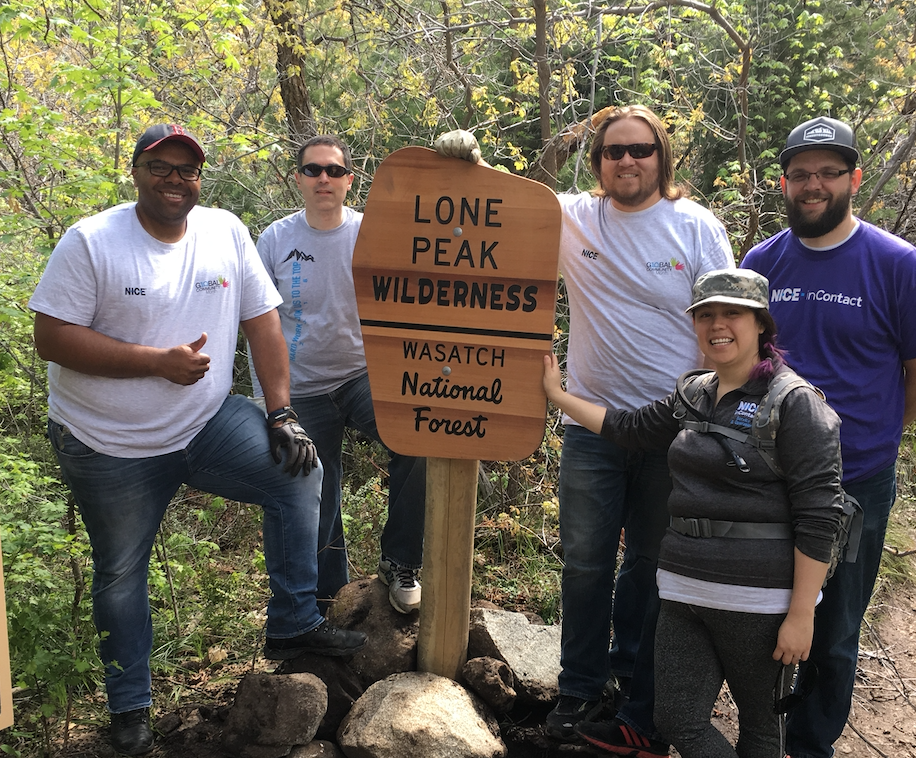
We know that the majority of the trash in the Cottonwood Canyons is not in the wilderness areas, but along the roadside. To improve the water and environment of the Central Wasatch Mountains we set up five volunteer days to pick up trash in Big Cottonwood Canyon. We would like to thank CHG Healthcare for participating in four out of five volunteer days and The Grauer School of Encinitas, California for contacting SOC to set up the fifth. We were able to cover seven miles of Big Cottonwood Canyon while picking up 21 garbage bags full of trash. Each day as we picked up trash in BCC, it became clear that different areas of the canyon accumulated more trash than other spots. Not surprisingly, the areas with the highest amount of trash are at the base of the canyon, Butler to Mineral Fork, Mill D North/Reynolds Flat area, outside Spruces Campground area, and outside Solitude Ski Area — which see a lot of use. There are other areas in the canyon that could use a clean-up as well, but we expect to get to those next summer. We accomplished a lot but were unable to clean the entire Big Cottonwood Canyon Highway due to the all the other volunteer projects that we had going this summer. Also Save Our Canyons is a small five person operation. We are all busy with different projects and campaigns that we believe are worthwhile and can bring positive change to the Wasatch. If we are able to increase our funding towards projects like WSP or trash picks, we would be able to accomplish even more.
It was a pleasure working with the students from The Grauer School because I was able to provide their first experience in the Wasatch Mountains. Many of them had questions about the snow, animals, environment, and why the water that flows through these mountains is important. I was pleased to hear from some of the students that they perform trash pick-ups at the local beaches near their homes. They noticed that a lot of the trash we were finding was similar to what they find on the beaches, but that there was much more on the coast they reported that each day new trash lines the beaches. One of the teachers said that the beach in California could use it every day and that we in a way were lucky because the trash does not replace itself at the same rate that it does in the ocean. Even though our mountains might receive a lesser amount of trash, any is too much. It is of the utmost importance that all who enter and enjoy these mountains are thoughtful and considerate and contribute to keeping them pristine. These areas are not our homes, but the homes of the native plants and animals. When we are in the mountains, we are merely visitors.
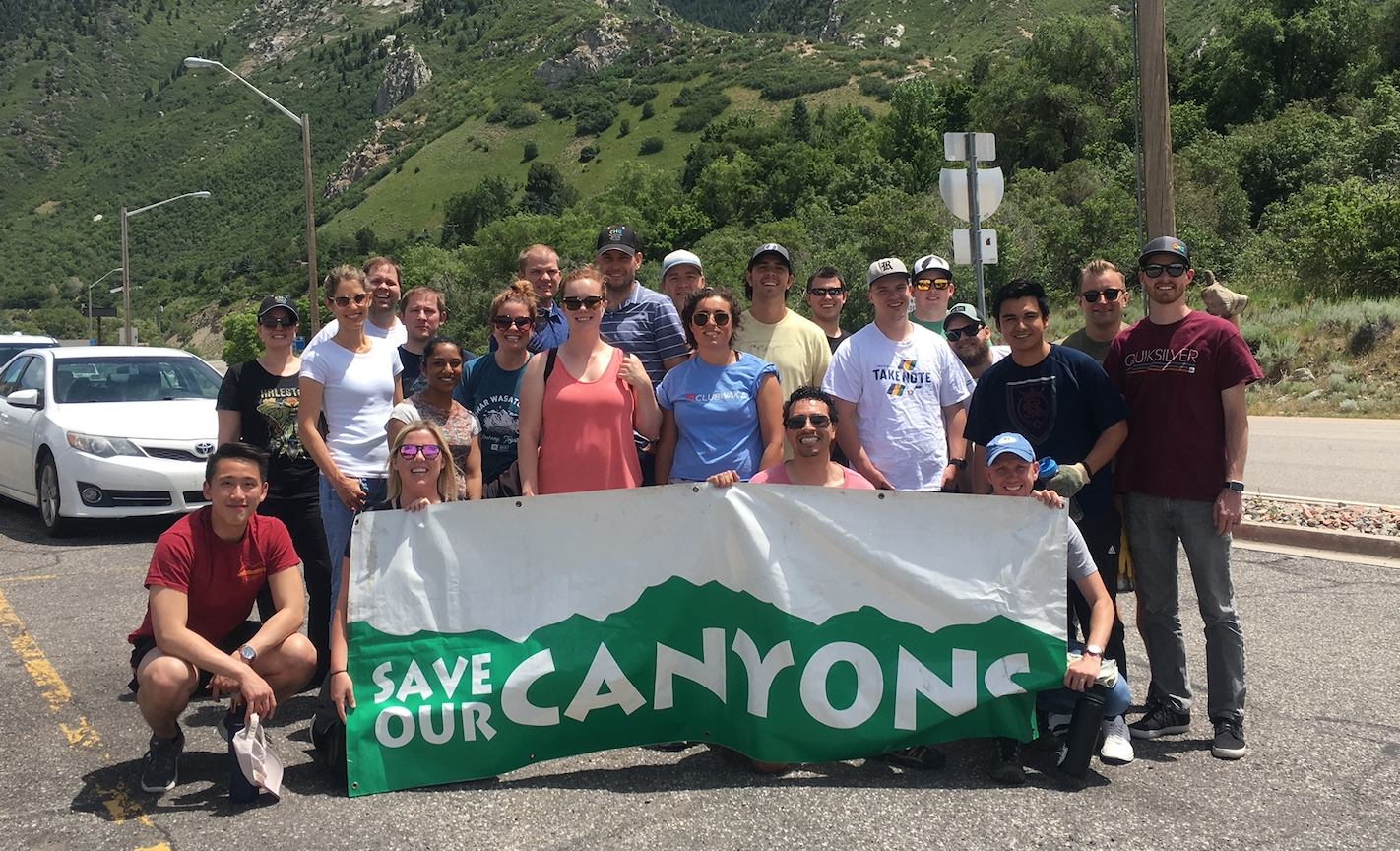
As summer came into full swing, our traditional Wilderness Stewardship Project began on June 15th with the focus on the Lone Peak Wilderness. Bells Canyon Trail was our first overused and unappreciated trail of this season. For this event, we cleared five water drainages, cut brush, and closed seven user made trails. As we were hiking up the trail, we noticed one thing that stood out quickly; the group size. We saw numerous groups hiking within the Lone Peak Wilderness that exceeded 20 plus people. Designated wilderness areas have group size limits to reduce the impact on the area and the group size on the Salt Lake Ranger District of Lone Peak Wilderness is 10 people. I strongly encourage anyone who hikes to get informed in the rules of the area the area that they choose. The rules exist for good reasons. Save Our Canyons has created a variety of opportunities to learn about the wilderness rules. We developed a wilderness education plan to educate the valley about wilderness areas in hopes that people recreating in these areas have a minimal impact. This education plan consists of web pages that are linked to our website, brochures that present the importance of these areas, their rules and how you can recreate in ways that are not detrimental to these areas. If you are interested in improving your knowledge or sharing the information about wilderness areas, you are more than welcome to stop by the office and grab some brochures or check it out on the wilderness tab on our website. Brochures are also available at our business partners which include Patagonia, Fisher Brewery, Momentum Gym, Wasatch Touring, Cotopaxi, IME and a couple others around the city.
During the remaining four WSP days, we spent our time focusing our efforts on the Red Pine Lake Trail due to the high use it experiences and also that it was being rerouted this past summer. During these four volunteer days we cleared 20 drainages, cut brush, closed nine user made trails, removed 10 illegal fire pits, and rerouted .2 miles of the Red Ped Pine Lake Trail. We were happy to participate in the lower reroute of the two reroutes on the Red Pine Lake Trail to make it easier for hikers and to improve water drainage off the trail to lessen the impacts of erosion. The Salt Lake Ranger District, with the help of other local districts, The Cottonwood Canyons Foundation, and the community came together to accomplish this. The reroute was beautifully done and I suggest that everyone take a stroll up this trail to see all the work that was done by people who care for these areas. While we were rerouting the trail, many hikers commented on the new trail, mentioning that it is much easier and that the reroute was beautiful and was well done.
One of my favorite parts about the Wilderness Stewardship Project is meeting the volunteers and listening to the stories they have about the Wasatch and how it has changed. I enjoy hearing about their experiences hiking throughout the world and in Utah, and why they were inspired to volunteer with Save Our Canyons. One common theme is that every volunteer shares an appreciation of the Wasatch and has a darn good story to share as well. Our experiences in the mountains, whether in the Wasatch or another range, shape us to be outdoor enthusiasts and engaged activists. Mountains bring people together and shape the beliefs of communities. When we get together, it’s obvious that we share common goals for the future of these mountains and wilderness areas.
As the WSP season came to a wrap, we had our last volunteer day on October 5th with plans to remove illegal fire pits from Red Pine Lake. As the morning of the 5th arrived, I drove to the Little Cottonwood Park and Ride to meet the volunteers who had contacted me. I was expecting a usual turn out of 5-7 volunteers who were ready to dedicate their Saturday to improving our wilderness areas. But as I waited outside my car on this chilly fall morning, volunteers started to arrive. A few volunteers arrived, but to my surprise, the stream continued until my car was surrounded with people of all ages ready to conquer the Red Pine Lake Trail one more time. An astonishing 18 volunteers came out to show their appreciation and dedication on our last day of the year.
Previously, our highest turn out over the 12 WSP volunteer days over two years was 8 volunteers. It warmed my heart to see the age range of those who came to help out. We had students from local high schools as well as adults in their retirement. High volunteer turn out is an important factor for this project because we are able to cover more ground and spread out the workload. With 18 volunteers we were able to have two groups of nine split up to cover both sides of the lake. Due to it being late in the season, the lake was very low, which uncovered most of the trash that was in the area. It ws sad to see the accumulation of broken glass that was found around and in the lake. It was also discouraging to see how many illegal fire pits were in the area. The Forest Service does not want dead wood to be burned because it provides homes to birds and insects as well provides nutrients to the soil so that plants can grow. The fire rings also scar the earth leaving black stains in our wilderness areas. It is my hope that more and more people each year will educate themselves and others about the Wasatch and how to recreate properly in this area so that we can keep these mountains healthy. I strongly encourage anyone who is interested to stop by our office to pick up informational materials or contact a member at SOC for further education. Over the past two seasons of running this project, I have noticed that it can be challenging to get people to show up to volunteer on their weekends, so it was thrilling to see the support over the course of the summer and especially on our last day. As a result of the volunteers’ efforts, we were able to make a larger restorative impact on the area. I would happily spend any weekend with these dedicated and passionate individuals working on improving the Wasatch.
Over the course of the summer we had 14 volunteer days where we worked with 130 volunteers. Thanks to our passionate group of outdoor enthusiasts, we performed 463 hours of volunteer work in the Wasatch Mountains through trash pick-ups, wilderness trail maintenance/restoration, and wilderness sign installations. Many agencies such as the Forest Service rely on volunteers to help them with projects such as trail maintenance or highway trash pick ups. This summer we saved the Forest Service and UDOT a combine $11,774.09 though our service hours to clean up and maintain the Central Wasatch Mountains.
I would like to thank everyone involved in helping to restore our Wasatch Mountains to what they should be. I encourage everyone to share their stories with friends and family about your time volunteering with Save Our Canyons because it is our hope that we can attract even more volunteers next year. It is our mission to keep these areas clean and with your help we believe we can continue to keep the Wasatch pristine.
Be a Member
Save Our Canyons relies critically on the support of individual members, local businesses, and volunteers – make a donation today.
Sample LTE by Ben Schoffstall
Bill H.R.5718 “Central Wasatch National Conservation and Recreation Area Act (NCRA)” is legislation that is critical to watershed health and resiliency. Support and movement of this bill is imperative, for it will safeguard watershed areas as well as public land in the Central Wasatch from future development and further fragmentation.
The Central Wasatch is a beautiful natural area that offers many values worth protecting— ecological, natural, scenic, cultural, historical, geological, and wildlife— Bill H.R.5718 lays out. Besides those values local watersheds provide over 60% of the water supply to the Salt Lake Valley. In a conservative estimation 30% of the Central Wasatch has been developed. If in further development the water that watersheds generate become contaminated local water treatment plants may not be able to process and supply water. The NCRA would establish a Watershed Protection Area which would ensure that watersheds are being properly managed and can continue producing pristine water.
Protecting public land keeps landscapes intact providing public with clean water, recreational opportunities, and accommodate population growth. With your support, collaboration with our elected officials and environmental organizations we can make the NCRA a reality, ensuring Utah has a clean and prosperous future.
New SOC Intern!
Ben Schoffstall
I was born in Sandy, Utah, a city located along the Wasatch Front. However, I grew up in Clayton, California which is similar to Sandy, it also has a close approximation to wilderness and areas of nature. Growing up I was very connected to nature, I had a passion for collecting and identifying insects, exploring local trails, and visiting National and State Parks. Throughout high school and college, I enjoyed many outdoor activities including: cycling, swimming, hiking, backpacking, and competitive cross country running. I was also a member of Boy Scouts and through this experience I had the opportunity to hike the entire John Muir Trail, a 211 mile trail, which exposed me to breathtaking landmarks and landscapes in several wilderness areas along the Sierra Nevada mountain range. It was through my Boy Scouts of America experience, especially the journey leading up to earning the rank of Eagle Scout, that really inspired me to want to protect the environment, including its natural resources and spaces. Eventually, preserving our environment became one my central passions, and an education and career goal.
I attended my local community college, Diablo Valley College, where I earned two Associate’s Degrees, one in Political Science and another in Natural Science. This fall I will be attending the University of California at Santa Cruz where I will be working to obtain a degree in Environmental Studies combined with Biology.
I am extremely grateful that I was selected as an intern for Save Our Canyons, because their mission and staff are very motivating and inspiring. Furthermore, I am getting experience related to my studies, and am witnessing how environmental organizations identify, approach, and advocate environmental issues. This experience will truly be beneficial to local wilderness areas, my future, and hopefully to Save Our Canyons.
What’s With the Utah Inland Port?
Wasatch Environmental Update for July 21, 2019
By John Worlock
Here is a good question: “What’s with the Utah Inland Port?” Since there are a variety of answers, two weeks ago I attended some informative sessions hosted by Envision Utah, who are organizing surveys to figure out what the people of Utah want in a new Inland Port, or if they would rather not have one at all. I am pleased with what I learned, but I need to learn a lot more.
First of all, I was not entirely ignorant. Salt Lake City had begun to rezone some land in its so-called Northwest Quadrant, with the idea that some transportation-related development might take place in the future. The State of Utah decided that a good idea needed to be pushed along, They quickly set up an Inland Port Authority, whose major asset would be the control of the normally municipal tax revenues within a massive district stretching well beyond the borders of Salt Lake City. The State’s actions and words scared a lot of people who envisioned trains and diesel trucks and airplanes bringing in a lot of cargo and running it around in warehouses until it could be shipped elsewhere. It would be a very messy and polluting business, threatening the welfare of not only the nearby human population but also millions of migratory birds and lots of more stationary wildlife.
Two weeks ago some of those scared and upset people were protesting the Inland Port, and scuffled with police downtown, at the same time that we were calmly learning about it, in civilized discussions organized by Envision Utah. What a contrast! But I’m still upset and suspicious.
We are told that “nothing has been decided” and that it’s up to us, the public, to help with the decisions. But the Port Authority Board raises our suspicions by not opening its meetings to the public. If “nothing has been decided,” what has been going on in those meetings? What ambitious plans are in the minds of the board members?
Finally, before Envision Utah brings us a new survey on the Inland Port, I hope they take the trouble to help us learn about the current state of cargo traffic in and out of Utah and how the Inland Port would potentially change it.
Save Our Canyons Summer Pika T Shirt
Pika are a rabbit like mammal that inhabits Rocky Mountain slopes, known as talus in high elevation areas such as the upper reaches of the Wasatch Mountains. In North America, the Pika depends upon the forage of wildflowers, grasses, and mosses as its main source of food to sustain it year round. These intriguing little creatures, recognized from the “cheep” that reverberates amongst the granite fields of areas like White Pine and Mount Baldy are facing two major threats which is why we are highlighting them in our custom t-shirt designed by the talented Anna Hansen of The Hex Press.
For decades, our focus has been on preserving the highest reaches of the Wasatch Range that act as our reservoirs for year round water that supplies the population below. Research by the US Geological Survey between 2012 and 2015 found that climate change is the single most significant factor impacting this once broadly distributed herbivore. As the Pika’s populations decrease and they seek habitat at higher elevations the pressures increase due to existing and proposed development from ski areas in the Wasatch Range.
Like the Pika, Save Our Canyons is operating at a time where conservation of these important habitats is being undermined and the future is less and less certain. Therefore, your support goes a long way. Adding your voice and passion propels our message of comprehensive, landscape scale conservation and stewardship of the irreplaceable water source and lands of the Wasatch even further when you join us as a supporting member.
The other way you can help the Pika is by signing the Central Wasatch National Conservation & Recreation Area (CWNCRA) petition. Our current goal in partnership with Salt Lake City, Salt Lake County, Sandy City, the State of Utah and the USFS is to protect 80,000 acres of public land by working with Congress to designate the CWNCRA. Once passed, this legislation will connect fragmented land with areas currently under federal protection, designate additional wilderness areas, and limit future development on public domains of the Wasatch, all while protecting our shared values of natural places.
Take Action Today! Click HERE to support the Central Wasatch National Conservation and Recreation Area.

